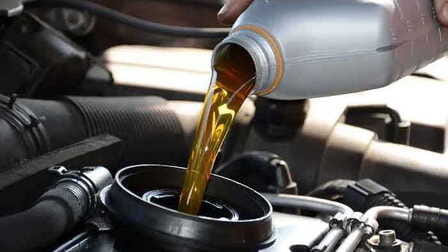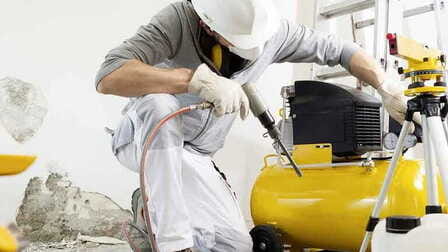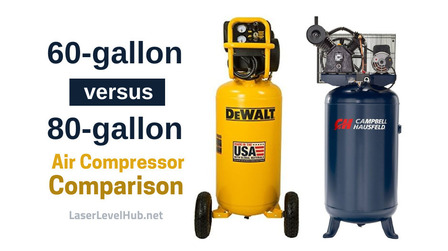Key Takeaways
Air compressors are rated according to several factors, including CFM/SCFM, PSI, HP, tank size, and duty cycle
You need to have a good understanding of your intended use cases
An air compressor for your home or garage can typically be small and portable
On the other hand, you should invest in a model with a larger air tank and more output if you’re planning to use it for heavy duty work
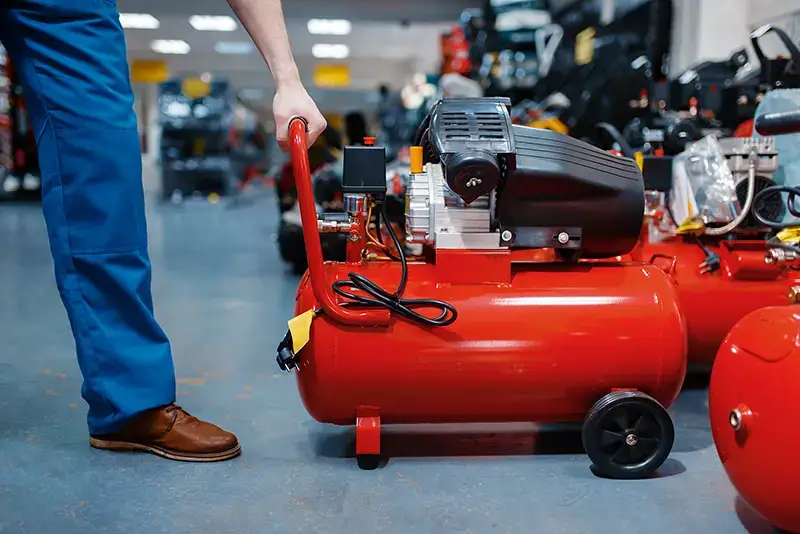
Air compressors are handy tools that have many different applications in our modern lives. If you're buying an air compressor for the first time, you might be a bit confused by the state of the market and all the different products available.
Understanding how to choose an air compressor is not straightforward. That's especially true if you have some more unique requirements for your project. If you're wondering “What size air compressor do I need?”, this air compressor buying guide is for you.
Air Compressor Basics
What is an air compressor in the first place? Put simply, this is a device which converts electrical energy to potential energy. This potential energy is stored in the form of compressed air which is dispensed on demand. Air compressors can be used for a variety of tasks. These include powering pneumatic tools, cleaning, painting, inflating tires and other gear, and much more.
As you're probably guessing, those different applications require different specifications from your air compressor. This makes it important to understand how different types of air compressors work and what you should be looking for.
If you’re buying a compressor for home use, you might want to look into getting more than one. This will allow you to cover all your bases when working with different air-powered hand tools.
Air Compressor Specifications
When looking at different air compressors, you’re going to see a number of different parameters. Understanding all of them in detail is important, even if you consider your project to have relatively lax requirements. So, what air compressor do you need in the end? Let’s have a look at the main specifications!
Air Flow (CFM/SCFM)
The air flow of air compressors is measured in cubic feet per minute (CFM) or standard cubic feet per minute (SCFM). The main difference between the two is that SCFM values are provided with the assumption of ideal conditions like temperature and pressure, and CFM on the other hand indicates the real consumption of the device.
Most handheld tools require between 1 and 20 CFM – a tire inflator requires 2, while an orbital sander ranges between 6 and 9 in most cases. Heavier tools usually require a higher air flow – for example, a sand blaster can require as much as 100.
Air Pressure (PSI)
The force provided by the air compressor is measured in pounds per square inch or PSI. You should note that CFM ratings are given for a specific pressure value. Simply put, CFM indicates how much air your compressor can deliver, while PSI indicates how much force is delivered through it. Most tools require at least 40 PSI, with some going up to 90.
Tank Size/Air Capacity
This one is pretty straightforward – it simply indicates how much air your compressor can hold. Larger tanks can be beneficial for longer jobs, like painting an entire car for example. With a small, portable air compressor, you would have to stop and wait for the tank to refill more often.
Horsepower (HP)
The horsepower rating of an air compressor indicates how powerful the compressor’s motor is. A higher horsepower rating typically means more CFM. However, you shouldn’t focus on the horsepower rating too much – more on that below.
Duty Cycle
With a reciprocating design, an air compressor switches between on and off states at regular intervals. The duty cycle rating indicates the proportion of time between the two states. With a duty cycle of 50/50, the compressor would be on for half the time and off for the other. A 75/25 rating means that the compressor will run 75% of the time.
Which Is the Most Important Number?
This might all seem a bit confusing – but don’t worry. If you’re shopping for an air compressor for the first time, the most important thing to remember is to pay close attention to the SCFM rating. This is the main bottleneck in powering a more demanding tool, and a higher SCFM will ensure that you can run all the different tools you want to use. That’s why all professional-grade compressors will place a strong emphasis on the SCFM rating in their specifications.
What Size Air Compressor Do I Need?
Here are some questions to ask yourself when choosing the right size for your air compressor.
What Do You Need an Air Compressor for?
One of the main points to consider is where you’re planning to use that compressor, and what kinds of tools you’ll be powering with it. There are three general scenarios to consider: home use, working at a jobsite, or in a workshop.
Home Use
Using an air compressor at home usually means inflating tires, painting cars, or doing general work with light-duty air tools like an airbrush or cleaner.
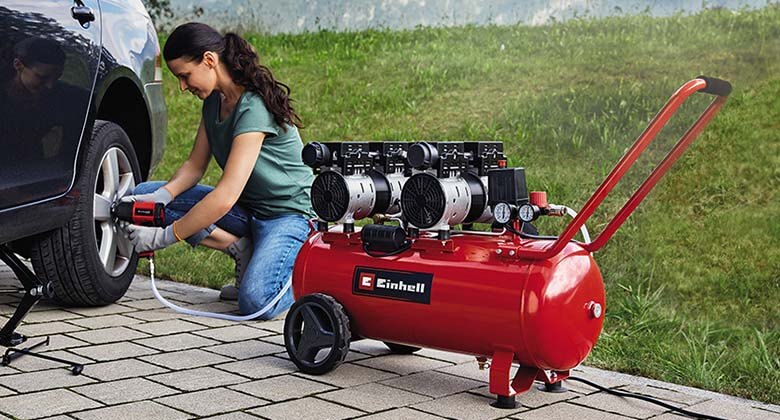
If you only need an air compressor for painting a car occasionally, then you can get away with relatively low specifications.
Jobsite
Most jobsites usually require more powerful compressors capable of running advanced tools like polish machines, flooring tools, nail guns, and more. For interior nailing jobs, look for a compressor with a tank size of 1-6 gallons, a PSI rating of at least 135, and SCFM between 0.7 and 5.0. Going above 175 for the pressure rating will usually not provide you with many additional benefits.
On the other hand, exterior jobs such as roofing and framing require an air compressor that is between 4-15 gallons, a PSI rating of 135 to 200, and an airflow of 4.0 to 10.0 SCFM, depending on the number of users.
Workshop
More advanced workshop uses include heavy duty auto tools, among others. Those require larger compressors – a tank size of 15-20 gallons should be a good start, with a pressure rating between 135 and 175, and SCFM of at least 4.0. Note that this is just for a single user – if you want to provide power to multiple users at the same time, your compressor requirements will scale linearly as well.
How Much PSI Air Compressor Do I Need?
You should focus on the SCFM/CFM ratings of the compressors you’re considering, and not so much on the PSI. Generally speaking, most tools you would use at home or at a jobsite require around 60-100 PSI. Meanwhile, many air compressors can provide at least 135 PSI, so you should be able to power most of your required tools without trouble.
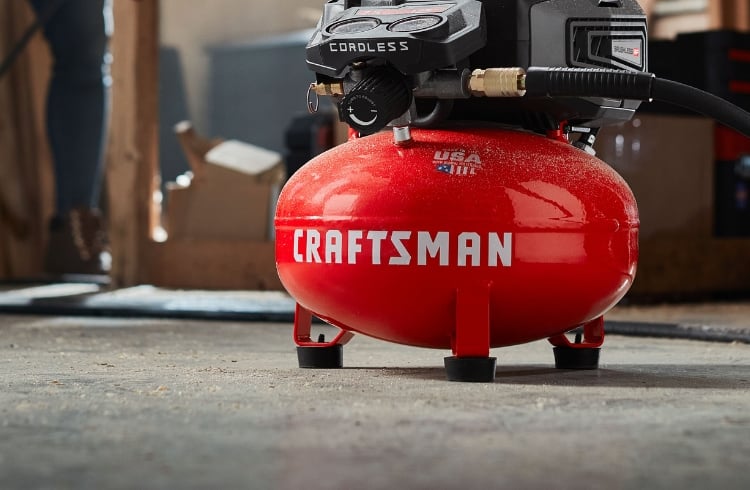
How to Calculate Compressor SCFM/CFM?
Understanding how much CFM your air compressor needs is the most important point here. The right choice will depend on several factors:
- What tools are you using?
- How many of each do you have and need to power simultaneously?
- What are your usage habits?
1 - Types of Air Tools
All air tools have their CFM requirements listed in their specifications. Make sure to go above what’s indicated by the manufacturer by at least 50% though. Simply multiply the tool’s stated required CFM by 1.5, and you will get a rough value to guide you in your search for the right air compressor. Pay attention to the duty cycle as well, as some tools require more continuous air than others.
Recommended CFM = Required CFM x 1.5
2 - Number of Tools
In many cases, accounting for just a single tool should be enough. However, you might want to run several tools simultaneously in some cases, which would require a more powerful air compressor. As we mentioned earlier, the requirements tend to scale linearly here, so just add up the CFM ratings of your tools and multiply the final value by 1.5 as we described above.
3 - Continuous vs. Intermittent Use
Your usage patterns will dictate the necessary duty cycle. If you need something that requires constant air supply, you should get an air compressor with a 100% duty cycle. Otherwise, simply multiply a tool’s CFM by 4 to get the continuous CFM rating for it.
Continuous CFM rating for the tool = Average CFM x 4
4 - Tool Air Requirement Chart
If this seems a bit confusing to you and you just want an answer to the question “What size air compressor do I need for my air tools?”, here’s a handy chart to help you get oriented.
Tool | PSI | CFM |
Impact wrench | 90 | 4.0 – 5.0 |
Die grinder | 90 | 2.0 |
Brad nailer | 60 | 2.0 |
Framing nailer | 90 – 120 | 2.4 |
Jackhammer | 90 – 120 | 2.2 – 2.5 |
Sander | 90 | 15 – 20 |
Paint gun | 90 | 14 – 18 |
HVLP spray gun | 30 | 12 |
Hopper gun | 90 | 2.4 |
Plasma cutter | 80 | 1.5 |
Tire pump | 120 | 2.0 |
Air hammer | 90 | 4.0 |
Screwdriver | 90 | 5 – 10 |
Tank Size: How Big of an Air Compressor Do I Need?
Does an air compressor’s tank size matter? A larger tank will help you run your tools for longer periods without interruption. It may also be a requirement for some tools to operate properly in the first place. Here are some examples of tools with different air requirements:
- Low: blow gun, riveter, inflator
- Medium: saw, sander (1/2”)
- High: blaster, grinder, cutter
To figure out what size your tank needs to be, simply take the required SCFM of the tool and multiply it by 6. As a rule of thumb, try to still go above the resulting number to stay on the safe side.
Minimum tank size (litre) = Required SCFM x 6
Pay attention to how your tools work as well. If a tool requires a constant, uninterrupted supply of air, it will work best with a larger air compressor. On the other hand, something that only requires occasional bursts of air can work well with a smaller tank.
How to Size an Air Compressor: Other Considerations
There are a few other considerations to keep in mind when choosing the ideal air compressor. Convenience and the design of the compressor can matter a lot in some cases.
Portable or Stationary Air Compressor?
Think about your mobility requirements. Do you anticipate having to move the compressor around frequently, or do you expect to work mostly from the same location? You shouldn’t go for a portable compressor unless you specifically require it, because it will restrict you in certain ways.
Portable Air Compressors
Portable air compressors are designed to be easy to carry around. The compressor might have wheels, or even a simple handle if it’s light enough. Tank sizes vary between 1 and 30 gallons, but they are usually on the smaller side. These compressors are usually needed at large jobsites where workers need to perform duties in different areas throughout the day. The portable design makes up for most of the shortcomings, specifically the small capacity and the relatively low power.
Stationary Air Compressors
Stationary air compressors are much more powerful and flexible in their application. Their tanks come in sizes from 2 to 120 gallons, though most models fall in the 60-80 range. These compressors are perfect for smaller sites and situations where you don’t need to move around much. For example, you typically won’t need a portable air compressor for your home or garage. Smaller jobsites can also benefit from stationary air compressors.
Air Compressor Tank Styles
Air compressors come in many different designs. This factor can impact the size and portability of the model, among other things.
1 - Pancake Air Compressor
Pancake compressors are very common on the market. The name of this design comes from its external shape, which somewhat resembles a pancake. These air compressors utilize one single cylindrical tank which is laid down horizontally. A great advantage of pancake compressors is their portability. However, they achieve that by sacrificing their tank capacity. Pancake compressors are great for powering various small tools.
Tank size: 1-6 gallons
PSI: up to 165
SCFM: up to 6
2 - Twin Stack Air Compressor

A twin stack compressor, as the name implies, utilizes two tanks horizontally mounted on top of each other. These designs come with extra air capacity at the cost of some portability. This makes these compressors ideal for various medium-power tasks, including powering various tools such as spray guns and pneumatic machinery.
Tank size: 2-8 gallons
PSI: up to 125
SCFM: up to 15
3 - Vertical Air Compressor

The main thing that sets a vertical air compressor apart from other models is the vertical orientation of its tank. This makes for a relatively small horizontal profile, making these compressors a good choice for situations where you’re limited on space, like a small jobsite or your home garage.
Tank size: 30-120 gallons
PSI: 90-150
SCFM: up to 40
4 - Hot Dog (Horizontal) Air Compressor

Deriving its name from its appearance, a hot dog air compressor features a long tank that’s typically between 1 to 3 gallons in size. Though small, these compressors tend to be versatile and are frequently used at job sites.
Tank size: 1-3 gallons
PSI: up to 90
SCFM: up to 5
5 - Pontoon Air Compressor

The name of the pontoon compressor also comes from its shape, which resembles a pontoon. A cylindrical tank is laid on top of the base of the compressor, which looks like a pontoon. Apart from that, the design of the compressor resembles that of a pancake compressor quite closely. Pontoon compressors are used in similar situations to pancake compressors, but they typically bring some extra air capacity to the table.
Tank size: up to 8 gallons
PSI: up to 155
SCFM: up to 7
6 - Wheelbarrow Air Compressor

A wheelbarrow compressor is designed to be as portable as possible. This is accomplished thanks to the wheelbarrow design, allowing the operator to move the compressor around with ease. Wheelbarrow compressors usually come with one or more wheels for additional stability and portability.
If you're looking for a portable compressor with the biggest storage capacity possible, you'll likely want to look at a wheelbarrow model.
Tank size: up to 20 gallons
PSI: up to 155
SCFM: up to 15
7 - Truck-Mount Compressor
Truck-mount compressors, as the name implies, are meant to be installed on trucks and not moved around on their own. These compressors are typically large and powerful, and intended for heavy duty work. They are popular among professionals and are rarely bought for home use.
Tank size: up to 120 gallons
PSI: up to 175
SCFM: up to 100
What Size Air Compressor Do I Need? Frequently Asked Questions
Can I use a smaller compressor than recommended for my tools?
What size air compressor for a home garage?
What size air compressor for a small shop?
What size air compressor for changing tires?
What size air compressor do I need for an impact wrench?
What size air compressor for a die grinder?
What size air compressor for a brad nailer?
What size of air compressor for a framing nailer?
What size air compressor for a roofing nailer?
What size air compressor for a jackhammer?
What size air compressor do I need for soda blasting?
What size air compressor for sanding a car?
What size air compressor for painting a car?
What size air compressor for an HVLP spray gun?
What size air compressor for a hopper gun?
What size air compressor to blow out a sprinkler system?
What size air compressor to winterize RV?
What size air compressor do I need for a plasma cutter?
Conclusion
This gets the basics out of the way. There are a few other considerations you might want to keep in mind – for example, how you prefer to power your compressor, whether you insist on an oil-free design, and how much noise you can tolerate. Knowing how to calculate an air compressor’s size is only part of the equation – determining what is a good size air compressor for home use will differ a lot from one person to another.



